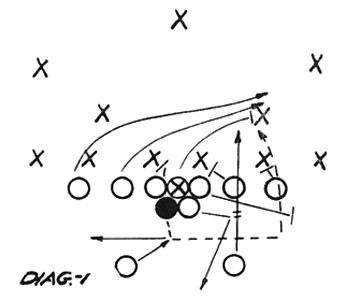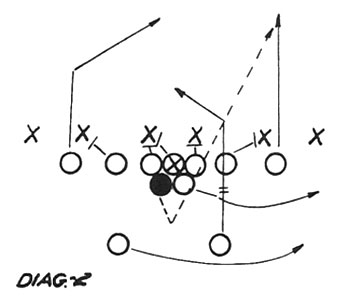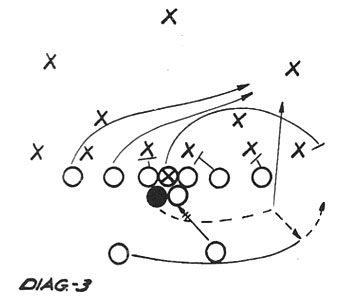Double T — Double Trouble
October 22nd, 2007
Special thanks to Jim Barg and Bryan Lane for the materials
“Revolutionary Football” — 1953
By Vassa Cate
Head Football Coach, Waycross High, Waycross, GA
Yes, the double-T is double trouble and with the clear interpretation that the rules committee has now put upon the use of the double quarterback, look for us to come out with more than just a few scattered plays from that formation.
For several years we fooled around with it here at Waycross and were really sold on the set. The officials, though, took a dim view of the way that we liked to line up the boys with both quarterbacks up and under, one on each cheek of the center. At the pivot, we tried to get big boys who could really stretch out, but that was not always possible. Because of this, we used fewer and fewer double-T plays. Now that a player is considered to a be a yard behind the line if there is daylight between the back and the lineman, we can put both boys up and under as far as we want as long as there is no contact. Therefore, we think that we can operate effectively again.
There are several reasons for the effectiveness of the double-T plays: all the pass patterns can be worked in, the deception lending itself exceptionally well to the passing game by causing rushers to become more cautious, thus giving more time with the same amount of protection as you would have from the straight-T; the double quickies and bootlegs prevent the defense from “keying” on your quarterback as can be done in conventional stuff; the possibilities of split-T plays or one side split and the other normal; the defenses will have to play fairly normal, giving you a better chance at normal blocking. Slants, loops, overshifts become too dangerous when you “can shoot with either barrel.”
I am well aware that many others have used the double-T to some extent and have written some little material about it. For that reason, I am going to tell some of the things that we did which are somewhat different from what the others advocate. Some of these are:
1) Our quarterbacks were angled in at 45 degree angle instead of straight back side by side.
2) We used a reverse pivot in order to hide the ball and enable the boys to get around faster.
3) We used a lot of bootleg plays.
4) We use it as a formation from which to shift into others; such as, the single- or double-wing, the winged-T.
5) A normal alignment on one side is coupled with an unorthodox set-up on the other so that a normal defense cannot be used.
The plays outlined in the remainder of the article are not all that we use nor is a play shown to more than one side. These are the ones that have brought the best results for my teams.
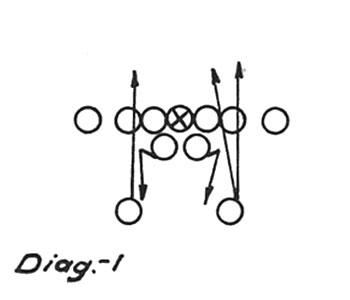

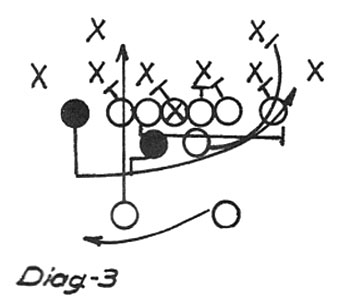
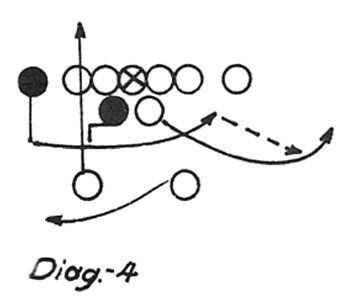
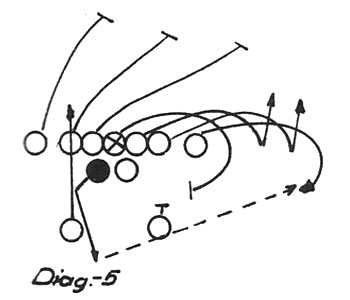
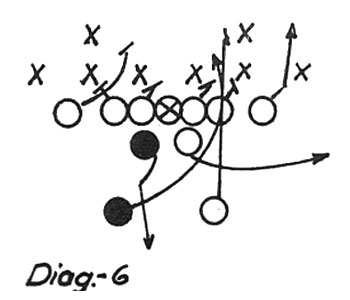
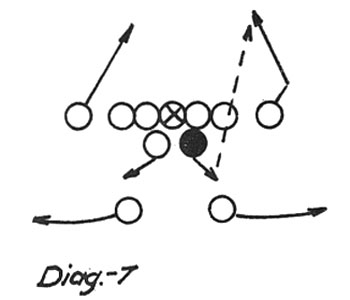
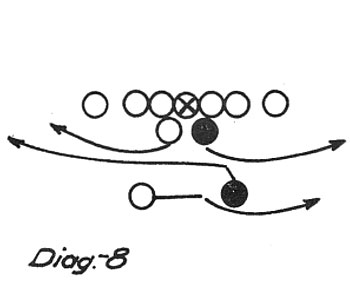
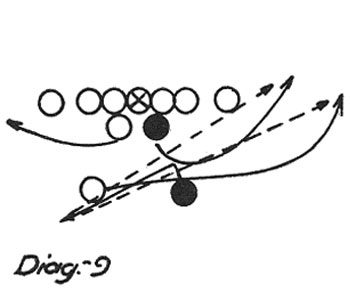

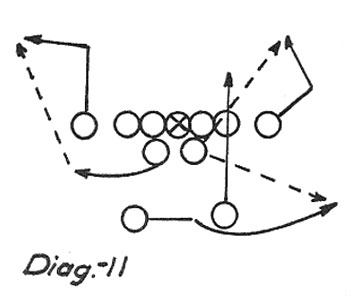
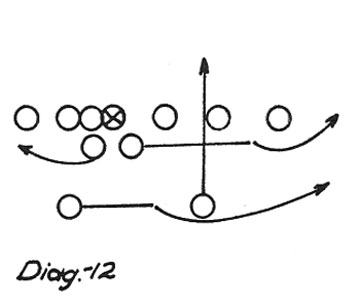
Well, boys, there it is! I have told you what we try to do with the double-T and given you some of the plays with which we have had some success. It is always a little presumptuous in any coach to write too much about what he has done or is doing, but if this makes you think a little along football lines it has been worthwhile. It is a cinch that your use of two quarterbacks will make your opponents think plenty.
Coach Cate attended Glynn Academy, Brunswick, Georgia, where he participated in football, basketball and track. At the University of Georgia he participated in track and football for three years and was captain of the football team in 1939. He was high-point man in track in the Southeastern Conference for two years. He won first place in the 100-yard dash in 1938 with the time of 9.8 sec. In 1940, he set a low hurdle record of 23.1 sec.
He began his coaching career in 1940 at Riverside Military Academy, winning the GIAA track meet. Since 1941, he has been at Waycross High School as coach of football and track. His football teams have won 56, lost 35 and tied one. His 1952 team won nine games, and lost only to Valdosta, the state champs.
Principles of the Double T
October 1st, 2007
Special thanks to Jim Barg and Bryan Lane for the materials
“Revolutionary Football” — 1953
By Herbert “Swede” Phillips
With the defense rapidly catching up with the T formation offense, some coaches are turning to the single wingback formation, substituting power and deception for speed and quickness. Others will seek variations of the T; such as, the spread T, or the T with two quarterbacks — the Double T. This last-named formation is the one with which I have experimented extensively and to which I turned when my regular brand of T proved to be too weak.
Long before the inimitable Frank Leahy stated that the Double T is the trickiest football formation now known, several coaches in this section were experimenting with this tricky yet powerful offense. Besides the author, several of these strategies are Paul Vespa (Herndon, Virginia High School), Ed Shockey (Dobbyns-Bennett High School, Kingsport, Tenn.), Vassa Cate (Waycross, Georgia, High School). W.J. kirksey (Jonesboro, Georgia, High School), Maxwell Ivey (Atlanta, Georgia, Murphy High School), and Tom Nugent (Now at FSU).
Since very little has been published about this formation, each of these coaches has arrived at his theories and devised plays more or less independent of all others. Before talking to any of the others or reading the little that has been written on this offense, I drew up a series of plays with two quarterbacks and conducted a spring practice using this offense only. The results were very satisfactory. In three scrimmages with other schools (then legal), we found most of our plays very effective. By typing the unsuccessful plays, checking with the boys, talking to other Double T men of my acquaintance, and re-reading the Vespa (Southern Coach and Athlete, Oct., ‘46) and Shockey (Southern Coach and Athlete, Nov., ‘47) articles, I was able to establish principles which have since served as a workable basis for a deceptive, powerful offense. Here they are:
I. Place all pressure upon one sector of the defense. My first idea was to run every play the same way to both sides at the same time as if it might be in duplicate. We even called them double dive, double quickie, double cross buck, double pass. It soon became apparent that the defense caught on to this much faster than they did to the others for it played each side separately. When I began to put all the pressure to one side, the offense ran much better.
II. Keep the defensive backs playing out of position. By having one quarterback always throwing or faking the throw while the other is either running or faking a ground play, the defensive backs either are held in position so that a good gain is certain or they are caught so that a long gain results.
III. Employ the quarterbacks (one or both) as flankers or men-in-motion. With one quarterback flanking and the other under, all the deception, power and effectiveness of the single wing may be obtained with a direct snap. The buck lateral series may even be run. With both out, the formation approximates the dangerous double wingback formation. How the passing is helped!
IV. Utilize one quarterback in double team line blocking or trap blocking. The angle that this player has is as good as or better than that of the blocking back in the box.
V. When the line adjusts, don’t split the guards more than 18 inches. Since the quarterbacks are the hub of the whole attack, they must have as much protection as possible.
VI. If another formation is used with the Double T, use the same blocking for plays to the same hole.
After the spring practice experimentation, we later put this system into our offense along with our standard T attack. it proved to be very effectual and saved at least one game for us that season. When I first wrote of this formation in Coach and Athlete, the article brought a request for plays from the coach at Shamrock, Texas. I obliged him and was gratified to learn that although he ran just one Double T play in Texas playoff, it went seventy-odd yards for a score.
“If this formation is so wonderful, why doesn’t everyone use it?” Obviously, there are some disadvantages. Here are four that are offered as disadvantages.
1. Although the rules are very specific and the matter is cared for specifically in the Play Situations, officials are possessed of a great ignorance as to how to call the plays.
2. Blocks seem to need to be held a fraction of a second longer than a regular T block.
3. A suitable system of signals must be devised to care for the additional fake and faker.
4. Most coaches will not attempt it unless all the material fits the specifications.
Of these, only number 1 is valid — and it need not be. The book makes it clear that if there is one yard distance between the ball and the added quarterback that it is not an illegal formation under any circumstances. The case book brings out that if there is daylight between the quarterback not receiving the ball and the center that he is back the required yard. Nevertheless, the variety of interpretations keeps the boys edgy and jumpy. see that the officials association, and especially those that you use, understand the rule and the way that you operate the formation. We have tried it both ways and would rather have both quarterbacks with their hands in contact with the center. However, the boys can place their outside legs forward in such a way as to screen from the defense the fact that one of them may be showing daylight between his hands and the center’s rump. Actually, it has been worked successfully with both quarterbacks backed up an additional couple of feet and accepting a short, fluffy snap from the center. The McKinley (Ohio) coach, Bup Rearick, lectures upon this formation and method of running it at the Purdue Coaching Clinic. He called it the box. The plays that you can get from it are good no matter how you play the quarterbacks.
The blocks are not held enough longer to be a serious disadvantage. The fact that you can run most of the regular T plays from the Double T without changes in blocking assignments will more than off-set the slightly longer time that the blocks must be held. Few T plays hold the blocks long enough anyhow. Perhaps using the Double T would help your regular T.
Any coach worth his salt can devise a signal system different from the old “back-hole” sequence.
Naturally, it would be helpful to have a really tall center to “get that yard,” and who wouldn’t like to have three better-than-average quarterbacks with on of them left-handed! We found that you can get by with one quarterback who is not a good passer by letting either the other quarterback or one of the halfbacks throw. We have been able to run rather effectively when one of the quarterbacks is only fair as a ball handler. We play other systems when we haven’t the perfect material, so we need not wait on the perfect set-up to try some TT.
